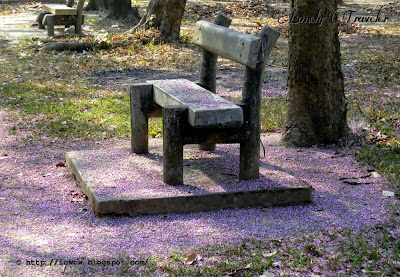| Bengali Name : | Monimala ful (মণিমালা / মনিমালা ফুল), মিলেশিয়া, Tuma (তূমা). |
| Common Name : | Moulmein rosewood, Jewels on a String, Millettia. |
| Botanical Name : | Millettia peguensis |
| Synonym : | Millettia ovalifolia |
| Family : | Fabaceae |
এই ফুলকে প্রথম দেখি রমনা পার্কে। বেশ কিছু গাছের সারি আছে রমনায়। সমস্ত গাছটাই গোলাপী ফুলে ছেয়ে ছিলো। পত্রঝরা বৃক্ষ হওয়ায় এই গাছে কোনো পাতা ছিলনা। শুধু ফুল আর ফুল। এই ফুলের নাম মনিমালা / মণিমালা। গাছের দিকে তাকালে মনে হবে অসংখ্য ছোট ছোট মালা ঝুলে আছে। প্রতিটি মালার সাথে ছোট ছোট শিম ফুলের মতন দেখতে ফুল যুক্ত হয়ে আছে, যেন মুক্তার মতন। একদম স্বার্থক নামকরণ, মনিমালা। আরো একটি নাম আছে, মিলেশিয়া। এই নামটা গাছটার বৈজ্ঞানিক নামের 'গণ' থেকে নেয়া। সব সময়ই গাছ থেকে টুপটুপ করে ফুল ঝরে পড়তে থাকে। গাছের নিচটায় ছেয়ে থাকে ছোট ছোট ফুলে।
Today I am going to introduce with a flower that is having a delicate blossom and the tree gets showered by myriad of flowers. Its name is Moulmein rosewood, Millettia, Jewels on a string, etc. This flower is native to the Myanmar. But later spread into the South and East Asian region. In Bangladesh we call this as Monimala (মনিমালা/মণিমালা), Mileshia (মিলেশিয়া), Tuma (তূমা), etc. I don't know who has given the Bengali name Monimala (মনিমালা/মণিমালা), but it is a perfect name for the flower, and also it goes with the literal translation of the English name 'Jewels on a string' [later I came to know that the name was given by the great professor Dwijen Sarma (দ্বিজেন শর্মা)]. Botanical name of this flower is Millettia peguensis with several synonyms. It belongs to the pea plant family Fabaceae.
Millettia (মনিমালা) is a small-medium sized deciduous plant. Leafs are imparipinnate (odd pinnate) and having 5-7 leaflets. Leaflets are small and ovate-elliptic shaped. It is mainly an ornamental flowering plant that usually seen around the parks, roadsides, etc. It drops all its leafs during Winter and brings millions of flower on the tree during Spring.
Millettia (মনিমালা) brings the one of the most attractive blooming flowers from many in Bangladesh. The flower is similar to any pea flower as the plant belongs to the pea family Fabaceae. Flower blooms as a cluster. During the blooming season (February-April) the tree gets totally covered with only the flowers. Small flowers use to hang around a long raceme that erects from the branches. Small flowers are purple in color with having an upper and a lower lip. Inside the base of the flower it has a tiny amount of touch of yellow and white. The bract of the flower is maroon in color. Flower converts into a legume fruit afterwards.
I have seen this flowering plant blooming at the Romna park, Dhaka (রমনা পার্ক, ঢাকা). Initially I thought it was a Gliricidia (Mexican lilac). But later I came to know that both were different species. The flower buds of the Millettia (মনিমালা) is totally different than the Gliricidia. The buds are less thick, less curvy for the Millettia (মনিমালা), but it is more thick and more curvy for the Gliricidia flower. Besides, the Millettia (মনিমালা) uses to hang around the raceme in such a way that they looks like a set of pearls are hanging around a garland.
The blooming season for the plant is very short. It brings numerous flowers on the tree, that's why during the blooming season you'll find the ground is covered with fallen flowers. Before withering the flower turns into mauve in color on the ground. At one morning I was walking at the Romna park (রমনা পার্ক) and found a corner was having 8-10 such trees and all were blooming profusely. The whole tree was in total purple and the ground was covered with as same. I have taken a sit on the bench under the tree. As it was early in the morning, the flowers were still resting on the bench as well. I have experienced the flowers were dropping on me from the tree very frequently.
Photos of this article were taken from the Romna park, Dhaka (রমনা পার্ক, ঢাকা). It was my regular visit to the park during March 2015.
This article has written by Lonely Traveler,
for the blog http://icwow.blogspot.com/

























Thanks for the beautiful take on this amazing flower!
ReplyDelete